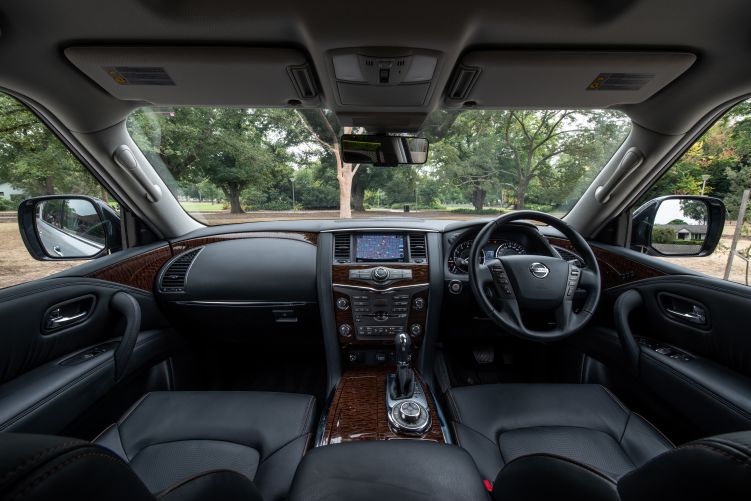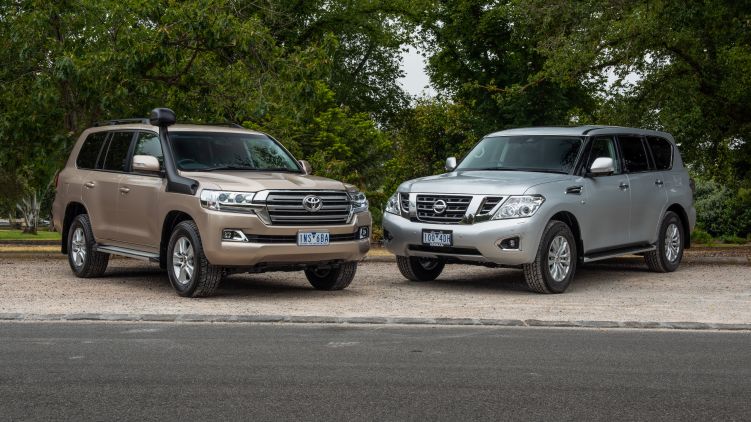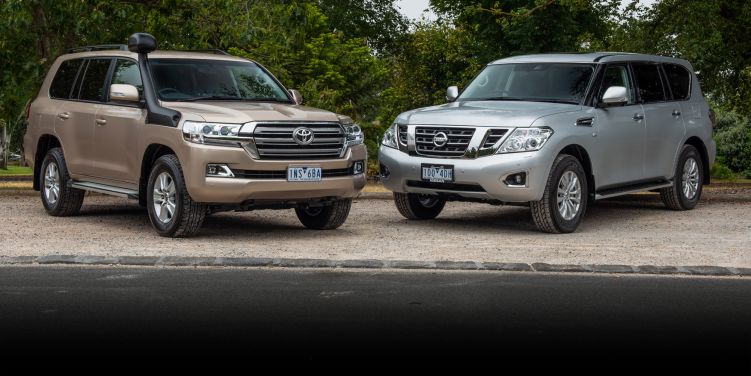Comparing the best SUVs: Nissan Patrol and Toyota Landcruiser put to the test
Sometimes the thought of a people mover sends chills down the spines of mums and dads that don’t want to make the metaphorical leap from cool parents to … just parents.
And that’s part of the reason SUVs have become so popular. They’re big, they have enough room for kids’ things and they can haul seven people in relative comfort. But, what if you need to throw another couple of requirements into the mix – towing and off-roading? Well, that only really leaves you with a couple of options.
We reckon two of the best options that tick all of those boxes in this segment are the Nissan Patrol and Toyota Landcruiser, so we pitted them against each other head-to-head in an on-road comparison. For the purposes of this comparison we’ve excluded towing and off-road driving, because we’ve done plenty of that in the past.

Specifications
You may not think it, but Nissan sells virtually every Patrol they can get their hands on. That’s partly thanks to the relatively sharp pricing and standard specification levels. Kicking off from $72,880 (plus on-road costs), the Patrol range includes two variants, the entry-level Ti and the Ti-L tested here, which jumps up to $89,880 (plus on-road costs). There’s a big price difference between the entry-level Ti and the top-specification Ti-L variants, but we think it’s not really worth forking out the extra money given the standard level of kit available in the Ti model.
Standard equipment includes leather interior, 18-inch alloy wheels, full-sized spare tyre, eight-seats, eight-way power driver and front passenger seats, three-zone climate control, cruise control, 8.0-inch infotainment system with satellite navigation, six-speaker sound system with two USB inputs, automatic up/down on all windows, sunroof, automatic headlights and windscreen wipers, front and rear parking sensors, keyless entry and keyless start.
Read more: LandCruiser news and reviews
The Ti-L adds features like an intelligent rear-view mirror, memory for the driver’s seat position, electric steering adjustment, dual 8-inch entertainment screens in the second row, 13-speaker Bose sound system, chilled centre console, radar cruise control, blind spot monitoring, lane departure warning, power operated tailgate, xenon headlights with automatic levelling and washers and puddle lamps.
Curiously, the Ti-L drops seating capacity from eight to seven (the third row offers two seats instead of three). Either way, the price difference doesn’t really justify the extra equipment. They are ‘nice to haves’, as opposed to things you desperately need to spend that kind of coin on.
While the Toyota Landcruiser GXL is technically one up from the entry-level diesel-powered $78,190 Landcruiser GX model, the GXL is the civilised option that most consumers would consider given the somewhat spartan interior on offer in the GX. The GXL starts from $84,480 (plus on-road costs) for the naturally aspirated petrol V8, with the vehicle tested here the more popular V8 turbocharged diesel diesel GXL, which is priced from $89,580 (plus on-road costs) – just $300 short of the Patrol Ti-L.
Standard equipment in GLX trim includes dual-zone climate control, LED headlights with automatic levelling, full-sized spare tyre, 6-way manual seat adjustment, cloth interior, keyless entry and start, automatic up/down on all windows, 12V and 220V power outlets, cruise control, 6.1-inch infotainment display with inbuilt satellite navigation with USB input, six-speaker sound system, front and rear parking sensors and reverse-view camera. Both vehicles are fairly well equipped, but it’s not hard to see that the Patrol eclipses the Landcruiser on standard equipment – even at its basic Ti trim level.
Design and packaging
While there is a considerable difference between these two in terms of specification levels, stepping inside the Patrol feels like briefly going back in time. It’s filled with that older style of lacquered woodgrain (that’s if it’s even wood) and it harks back to a time when more buttons translated to a more premium vehicle.
Put the older style to one side and you won’t find a surface inside the cabin that isn’t softly padded or made with durability in mind. It feels like you could drive directly across the centre of the country and the car would feel like it did the day it rolled down the production line.
Being the top specification there are heated seats, cooled seats, a cracking sound system and leather as far as the eye can see. Getting in and out of the second row is a breeze, but what took us by surprise the amount of leg and toe room in the second row. Even for a tall adult with their seating position quite far back there is plenty of room for a tall adult to sit behind them and feel comfortable.
You could comfortably also sit three adults abreast in both of these vehicles. Kids will find the third row accommodating and comfortable, but it’s a bit of a tight squeeze for adults. Cargo capacity is absolutely incredible. There’s 550 litres available behind the third row (which is usable space, unlike some seven-seat SUVs), which expands to 1,490 litres with the third row folded away. Drop the second row as well and the space expands to 3,170 litres – that’s some serious cargo capacity.
The infotainment system is pretty basic and can be quite frustrating to use. The voice recognition system isn’t very good, which means most inputs need to be manually made via the screen. It lacks smartphone mirroring (which would make it slightly more bearable), so each function needs to be found through layers of menus. Most painful being inputting satellite navigation destinations.
Nissan really needs to pick up its game on the infotainment front. While we’re seeing smartphone mirroring coming through on the Leaf, it’s desperately missing from the volume products in Nissan’s range.

In terms of four-wheel drive equipment, there’s 272mm of ground clearance, a 34.3 degree approach angle, a 26.2 degree departure angle and a litany of four-wheel drive gear. This includes a rear differential lock with helical limited slip differential, hill descent control, low range transfer case and several selectable off-road modes.
If the Nissan Patrol’s interior is the equivalent of stepping back to a time when woodgrain was the ‘in’ thing, the Landcruiser’s interior is the equivalent of a time where hard, rugged plastics teamed with velour seats to define style.
Sure, the Landcruiser’s interior feels a little more modern than the Patrol’s, but it’s nothing to write home about. It features one of the world’s oldest colour infotainment systems and the blank buttons strewn throughout the cabin remind you of the countless features you’re missing out on.
While you do miss out on a lot of equipment fitted to the Patrol, there’s enough there to keep you happy. The functions are fairly easy to use with outward visibility in both cars good, despite their respective sizes. The second row is accommodating, but lacks the leg and toe room of the Patrol. We found it hard to get comfortable with a taller passenger in the first row.
Read more: LandCruiser v Patrol off-road (2016)
With that said, the third row was easier to fit adults and was a more comfortable place to be shoehorned in comparison to the Patrol. Cargo capacity in the third row isn’t amazing and that’s partly due to the third row of seats folding towards the windows as opposed to into the floor.
That means there’s around 700 litres available with the third row folded away and 2,170 litres with the second row folded forward. It’s not quite as versatile a space as it is in the Patrol. Like the Patrol, the Landcruiser’s infotainment system is pretty poor. It’s a generation behind the latest crop of Toyota infotainment systems, which means it’s slow, it has an incredibly poor voice recognition system and it lacks any form of smartphone mirroring.
Four-wheel drive equipment comes in the form of a 230mm of ground clearance, a 32 degree approach angle and a 24 degree departure angle. There’s also a low-range transfer case with a Torsen centre differential lock and several crawl control modes.
Optional in the GXL is KDSS, which is an Australian developed hydraulic suspension system that prevents body roll while the car is in motion and allows extra wheel articulation in off-road conditions. Both vehicles offer a 3,500kg braked towing capacity.
Engines and performance
We wanted this comparison to be a price-derived comparison as opposed to a like-for-like engine comparison. We were also keen to see how the petrol and diesel alternatives fared in real world conditions in terms of consumption.
The Patrol uses a 5.6-litre naturally aspirated V8 petrol engine that produces 298kW of power and 560Nm of torque. It’s mated to a seven-speed automatic transmission with full-time four-wheel drive.
Officially, the Patrol uses a combined 14.4 litres of fuel per 100km. Our test loop included a highway run, a country run and a brief city stint. We measured an average fuel consumption of 11.6L/100km on the highway, 13.3L/100km after our country run with a total combined average of 12.82L/100km (average speed of 61km/h) once the 101km loop was complete.
Read more: Patrol news and reviews
This engine is as smooth as silk. Stab the throttle in any gear and instead of hunting it will just lean on its torque curve to subtly propel it forwards.
Give the throttle a proper poke from standstill and it absolutely moves. It’ll do 0-100km/h in under seven seconds, which is pretty impressive for a vehicle that weighs the best part of 2,700kg. It features a 140 litre fuel tank, which means you could get a theoretical 1092km of driving range at our averaged fuel economy.
The Landcruiser uses a tried and tested 4.5-litre turbocharged diesel V8 engine that produces 200kW of power 650Nm of torque. It’s mated to a six-speed automatic transmission and uses full-time four-wheel drive. Toyota claims a combined average fuel consumption of 9.5L/100km. Like the Patrol, our test loop included highway, country and a brief amount of city driving.

We measured an average fuel consumption of 10.5L/100km on the highway, 12.5L/100km on or highway run and a final combined average of 12.0L/100km with an average speed of 58km/h. Much like the Patrol, this diesel engine is a ripper. It’s incredibly smooth and gives the impression its in for the long haul. Nothing seems to bother it with torque always available on demand.
We have heard reports from some owners of issues with the air filtration system allowing dust to enter engine side, but Toyota is yet to address or admit any faults with the engine. It’s not as quick as the Patrol in a straight line, but with 650Nm of torque it gets along nicely and is confident when it comes to overtaking.
Fuel is stored in two diesel tanks, one main 93 litre tank and a sub tank that caters for 45 litres of capacity. With a theoretical 138 litres on offer, it could travel 1,150km on a single dose of fuel at our achieved average fuel consumption. The Landcruiser tips the scales at 2,740kg.
On the road
On the open road these two vehicles achieve the same goal – moving people and potentially towing big loads – but the way they achieve these tasks is markedly different. The Patrol soaks up miles beautifully thanks to a hydraulic body control suspension. This clever system (not dissimilar to the optional KDSS system offered in Landcruiser) aims to move hydraulic fluids around each corner of the car to offset body roll.
By shifting hydraulic fluid to a corner of the vehicle while it’s under load during cornering, that corner’s suspension roll stiffness is increased, which acts to keep the body flat. In theory it works pretty well. At highway speeds if you enter a tight corner the body remains flat – there’s no escaping the maneuverability of its rolling mass, but it makes the motion through a corner manageable.
In addition to the hydraulic suspension components, the rest of the system is a double wishbone type with coil springs at the front and rear.
Nissan has worked to make steering the Patrol as easy as possible, but as a result of the light steering there is barely any feel through the rack. It’s not an issue in a vehicle this size, but it’s something worth keeping in mind.
Part of our loop included a heavily corrugated stretch of gravel road and allowed both of the vehicles to demonstrate their compliance over this type of rough terrain. The Patrol handled it with aplomb, simply gliding over the corrugations with little fuss. The only issue we encountered was the radar cruise control and forward collision systems disabling due to excessive shaking through the body. The systems were enabled again after a little while on smooth roads.
Overall, the Patrol was pretty impressive in terms of the way it drove and the way it soaked up country miles. The ride can be a little brittle over rough patches of road, but it’s barely noticeable and is simply with respect and in reference to the Landcruiser.
Despite not using the same hydraulic shifting suspension system as the Patrol, the Landcruiser does a great job with its underbody components. At the front end there is an independent double wishbone setup with coil springs, gas dampers and an anti-roll bar. The rear uses a four-link coil sprung setup with a Panhard rod, gas dampers and an anti-roll bar.
This setup caters for a softer ride than the Patrol, which can sometimes be described as floaty and ponderous. It doesn’t sit as flat as the Patrol through corners, but as I mentioned earlier, it barely needs to when you consider the type of driving you’ll be doing in it.
With that said it copes beautifully with undulating roads and potholes. It also flew over the corrugated section of gravel with no issues. There were a couple of issues with the vehicle’s controls, though. The steering is incredibly heavy – so heavy that at times it can become tiresome parking or moving the vehicle at low speeds.

The other part we weren’t a fan of was the brakes. Brake pedal feel is quite inconsistent and goes from being soft and grabby to quite firm and unresponsive. Brake pedal feel wasn’t as predictable as the Patrol and that resulted in moments where you felt a need to brake a little earlier to overcome that inconsistency.
We came away from the on-road component of our test surprised – we weren’t expecting the Patrol to be more consistent and more enjoyable to drive, especially on the country stretches of road where conditions get a little sketchier.
Ownership
Both Nissan and Toyota now offer a five year unlimited kilometre warranty, which is great news for buyers, Nissan even includes five years of roadside assistance as part of the deal. Over a three year period both vehicles require servicing every six-months or 10,000km.
The Nissan costs $3,236 to service over a three year period, while the Toyota comes in at a more manageable $1,680. It’s also worth noting that Nissan requires the Patrol to be fuelled with premium unleaded fuel of 95RON or higher.
VERDICT
We discovered as part of this test that there are options out there for mums and dads that need to move kids around but don’t want to settle for a people mover. These two SUVs deliver on space, relative performance and capability both on- and off-road.
The Nissan is the better of the two on many fronts, including its on-road manners, the way it delivers effortless performance and the litany of features that come as standard. It does fall short on the servicing front given how much it will cost you over a three-year period to maintain, plus the added cost of premium unleaded fuel.
But, if you’re happy to sacrifice a couple of the bells and whistles, it’s actually the Nissan Patrol Ti that we’d be going for. It’s some $16,700 cheaper than the diesel GXL or $11,600 cheaper than the petrol equivalent.
Assuming you’re travelling 15,000km per year (and using the official combined figures), that’s 6480 litres of fuel over a three year period for the Patrol, coming to $11,016 if you pay an average of $1.70 per litre of fuel.
Do the same distance in the diesel and petrol GXL and it comes out to $7267.50 for the diesel and $10,251 for the petrol over the same period (assuming the same fuel price). So that makes it $3748.50 better off in the GXL diesel and $765 better off in the GXL petrol.
Given the price gap, it’ll take you a little over 13 years to bridge the gap in the diesel and just over 45 years to make up the difference in the petrol. Just on numbers alone, you’re simply better off saving your money, buying the entry-level Patrol Ti and treating yourself to a nice holiday with the family.
Well, that’s our take on it anyway. So, if you’re in the market for these two, it’s the Patrol we’d go for if you want the vehicle that’s better equipped, better to drive and comes with a cracking engine.








 Proudly Australian owned and operated
Proudly Australian owned and operated